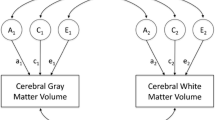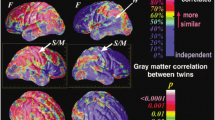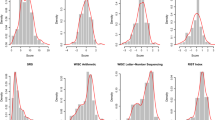Abstract
Children often show cognitive and affective traits that are similar to their parents. Although this indicates a transmission of phenotypes from parents to children, little is known about the neural underpinnings of that transmission. Here, we provide a general overview of neuroimaging studies that explore the similarity between parents and children in terms of brain structure and function. We notably discuss the aims, designs, and methods of these so-called intergenerational neuroimaging studies, focusing on two main designs: the parent-child design and the multigenerational design. For each design, we also summarize the major findings, identify the sources of variability between studies, and highlight some limitations and future directions. We argue that the lack of consensus in defining the parent-child transmission of brain structure and function leads to measurement heterogeneity, which is a challenge for future studies. Additionally, multigenerational studies often use measures of family resemblance to estimate the proportion of variance attributed to genetic versus environmental factors, though this estimate is likely inflated given the frequent lack of control for shared environment. Nonetheless, intergenerational neuroimaging studies may still have both clinical and theoretical relevance, not because they currently inform about the etiology of neuromarkers, but rather because they may help identify neuromarkers and test hypotheses about neuromarkers coming from more standard neuroimaging designs.

Highlights
We review neuroimaging studies investigating neural markers of traits transmission.
Studies have used both parent-child and multigenerational designs.
Studies provide insights but suffer from lack of methodological standardization.
Multigenerational studies should also account for shared environment.



Similar content being viewed by others
Data availability
No datasets were generated or analysed during the current study.
References
Abraham E, Posner J, Wickramaratne PJ et al (2020) Concordance in parent and offspring cortico-basal ganglia white matter connectivity varies by parental history of major depressive disorder and early parental care. Soc Cogn Affect Neurosci 15:889–903. https://doi.org/10.1093/scan/nsaa118
Ahtam B, Turesky TK, Zöllei L et al (2021) Intergenerational Transmission of Cortical Sulcal Patterns from mothers to their children. Cereb Cortex 31:1888–1897. https://doi.org/10.1093/cercor/bhaa328
Almasy L, Blangero J (1998) Multipoint quantitative-trait linkage analysis in general pedigrees. Am J Hum Genet 62:1198–1211. https://doi.org/10.1086/301844
Almasy L, Blangero J (2010) Variance Component Methods for Analysis of Complex Phenotypes. Cold Spring Harb Protoc 2010(pdbtop77). https://doi.org/10.1101/pdb.top77
Anger S, Heineck G (2010) Do smart parents raise smart children? The intergenerational transmission of cognitive abilities. J Popul Econ 23:1105–1132. https://doi.org/10.1007/s00148-009-0298-8
Bas-Hoogendam JM, Blackford JU, Brühl AB et al (2016) Neurobiological candidate endophenotypes of social anxiety disorder. Neurosci Biobehav Rev 71:362–378. https://doi.org/10.1016/j.neubiorev.2016.08.040
Bas-Hoogendam JM, Harrewijn A, Tissier RLM et al (2018a) The Leiden Family Lab study on social anxiety disorder: a multiplex, multigenerational family study on neurocognitive endophenotypes. Int J Methods Psychiatr Res 27:e1616. https://doi.org/10.1002/mpr.1616
Bas-Hoogendam JM, van Steenbergen H, Tissier RLM et al (2018b) Subcortical brain volumes, cortical thickness and cortical surface area in families genetically enriched for social anxiety disorder – A multiplex multigenerational neuroimaging study. EBioMedicine 36:410–428. https://doi.org/10.1016/j.ebiom.2018.08.048
Bas-Hoogendam JM, van Steenbergen H, Blackford JU et al (2019) Impaired neural habituation to neutral faces in families genetically enriched for social anxiety disorder. Depress Anxiety 36:1143–1153. https://doi.org/10.1002/da.22962
Bas-Hoogendam JM, van Steenbergen H, Tissier RLM et al (2020a) Altered neurobiological Processing of Unintentional Social Norm violations: a multiplex, multigenerational functional magnetic resonance imaging study on social anxiety endophenotypes. Biol Psychiatry Cogn Neurosci Neuroimaging 5:981–990. https://doi.org/10.1016/j.bpsc.2019.03.003
Bas-Hoogendam JM, van Steenbergen H, van der Wee NJA, Westenberg PM (2020b) Amygdala hyperreactivity to faces conditioned with a social-evaluative meaning– a multiplex, multigenerational fMRI study on social anxiety endophenotypes. NeuroImage Clin 26:102247. https://doi.org/10.1016/j.nicl.2020.102247
Bas-Hoogendam JM, van Steenbergen H, Cohen Kadosh K et al (2021) Intrinsic functional connectivity in families genetically enriched for social anxiety disorder – an endophenotype study. eBioMedicine 69:103445. https://doi.org/10.1016/j.ebiom.2021.103445
Bernabini L, Tobia V, Bonifacci P (2021) Intergenerational features of Math skills: symbolic and non-symbolic magnitude comparison and written calculation in mothers and children. J Cogn Dev 22:149–167. https://doi.org/10.1080/15248372.2020.1844711
Bertolero MA, Yeo BTT, D’Esposito M (2015) The modular and integrative functional architecture of the human brain. Proc Natl Acad Sci 112:E6798–E6807. https://doi.org/10.1073/pnas.1510619112
Bilgi MM, Simsek F, Akan ST et al (2015) The common brain structures correlated with personality traits in healthy mothers and their daughters. Klin Psikofarmakol Bül-Bull Clin Psychopharmacol 25:213–227. https://doi.org/10.5455/bcp.20150815033406
Bjorklund A, Hederos Eriksson K, Jantti M (2009) IQ and family background: are associations strong or weak? SSRN Electron J. https://doi.org/10.2139/ssrn.1439158
Black SE, Devereux PJ, Salvanes KG (2009) Like father, like son? A note on the intergenerational transmission of IQ scores. Econ Lett 105:138–140. https://doi.org/10.1016/j.econlet.2009.06.022
Braham EJ, Libertus ME (2017) Intergenerational associations in numerical approximation and mathematical abilities. Dev Sci 20:e12436. https://doi.org/10.1111/desc.12436
Brown S, Mcintosh S, Taylor K (2011) Following in your parents’ footsteps? Empirical analysis of Matched parent-offspring test Scores*: empirical analysis of parent-offspring test scores. Oxf Bull Econ Stat 73:40–58. https://doi.org/10.1111/j.1468-0084.2010.00604.x
Buckholdt KE, Parra GR, Jobe-Shields L (2014) Intergenerational transmission of emotion dysregulation through parental invalidation of emotions: implications for adolescent internalizing and externalizing behaviors. J Child Fam Stud 23:324–332. https://doi.org/10.1007/s10826-013-9768-4
Casey BJ, Epstein JN, Buhle J et al (2007) Frontostriatal Connectivity and its role in Cognitive Control in parent-child dyads with ADHD. Am J Psychiatry 164:1729–1736. https://doi.org/10.1176/appi.ajp.2007.06101754
Chen Q, Brikell I, Lichtenstein P et al (2017) Familial aggregation of attention-deficit/hyperactivity disorder. J Child Psychol Psychiatry 58:231–239. https://doi.org/10.1111/jcpp.12616
Colich NL, Ho TC, Ellwood-Lowe ME et al (2017) Like mother like daughter: putamen activation as a mechanism underlying intergenerational risk for depression. Soc Cogn Affect Neurosci 12:1480–1489. https://doi.org/10.1093/scan/nsx073
Davis T, LaRocque KF, Mumford J et al (2014) Anal NeuroImage 97:271–283. https://doi.org/10.1016/j.neuroimage.2014.04.037. What Do Differences Between Multi-voxel and Univariate Analysis Mean? How Subject-, Voxel-, and Trial-level Variance Impact fMRI
Endendijk JJ, Groeneveld MG, Mesman J (2018) The gendered family process model: an integrative Framework of gender in the family. Arch Sex Behav 47:877–904. https://doi.org/10.1007/s10508-018-1185-8
Etzel JA, Zacks JM, Braver TS (2013) Searchlight analysis: promise, pitfalls, and potential. NeuroImage 78:261–269. https://doi.org/10.1016/j.neuroimage.2013.03.041
Etzel JA, Courtney Y, Carey CE et al (2020) Pattern Similarity Analyses of FrontoParietal Task Coding: Individual Variation and Genetic Influences. Cereb Cortex N Y N 1991 30:3167–3183. https://doi.org/10.1093/cercor/bhz301
Fears SC, Melega WP, Service SK et al (2009) Identifying heritable brain phenotypes in an extended pedigree of Vervet monkeys. J Neurosci 29:2867–2875. https://doi.org/10.1523/JNEUROSCI.5153-08.2009
Fears SC, Service SK, Kremeyer B et al (2014) Multi-system component phenotypes of bipolar disorder for genetic investigations of extended pedigrees. JAMA Psychiatry 71:375–387. https://doi.org/10.1001/jamapsychiatry.2013.4100
Fehlbaum LV, Peters L, Dimanova P et al (2022) Mother-child similarity in brain morphology: a comparison of structural characteristics of the brain’s reading network. Dev Cogn Neurosci 53:101058. https://doi.org/10.1016/j.dcn.2022.101058
Flint J, Timpson N, Munafò M (2014) Assessing the utility of intermediate phenotypes for genetic map** of psychiatric disease. Trends Neurosci 37:733–741. https://doi.org/10.1016/j.tins.2014.08.007
Foland-Ross LC, Behzadian N, LeMoult J, Gotlib IH (2016) Concordant patterns of Brain structure in mothers with recurrent depression and their never-depressed daughters. Dev Neurosci 38:115–123. https://doi.org/10.1159/000444448
Fox AS, Oler JA, Shackman AJ et al (2015) Intergenerational neural mediators of early-life anxious temperament. Proc Natl Acad Sci 112:9118–9122. https://doi.org/10.1073/pnas.1508593112
Fox AS, Oler JA, Birn RM et al (2018) Functional connectivity within the Primate Extended Amygdala is heritable and Associated with early-life anxious temperament. J Neurosci 38:7611–7621. https://doi.org/10.1523/JNEUROSCI.0102-18.2018
Goos LM, Crosbie J, Payne S, Schachar R (2009) Validation and extension of the endophenotype model in ADHD patterns of inheritance in a family study of inhibitory control. Am J Psychiatry 166:711–717. https://doi.org/10.1176/appi.ajp.2009.08040621
Gotlib IH, Hammen CL (2009) Children of depressed parents. In: Handbook of Depression, 2nd edition, The Guilford Press. New York, pp 275–93
Gregg C, Zhang J, Butler JE et al (2010) Sex-specific parent-of-origin allelic expression in the mouse brain. Science 329:682–685. https://doi.org/10.1126/science.1190831
Haft SL, Myers CA, Hoeft F (2016) Socio-emotional and cognitive resilience in children with reading disabilities. Curr Opin Behav Sci 10:133–141. https://doi.org/10.1016/j.cobeha.2016.06.005
Harrewijn A, van der Molen MJW, van Vliet IM et al (2018a) Behavioral and EEG responses to social evaluation: a two-generation family study on social anxiety. NeuroImage Clin 17:549–562. https://doi.org/10.1016/j.nicl.2017.11.010
Harrewijn A, van der Molen MJW, van Vliet IM et al (2018b) Delta-beta correlation as a candidate endophenotype of social anxiety: a two-generation family study. J Affect Disord 227:398–405. https://doi.org/10.1016/j.jad.2017.11.019
Hill KE, Neo WS, Hernandez A et al (2020) Intergenerational transmission of Frontal Alpha Asymmetry among Mother–Infant Dyads. Biol Psychiatry Cogn Neurosci Neuroimaging 5:420–428. https://doi.org/10.1016/j.bpsc.2019.12.003
Ho TC, Sanders SJ, Gotlib IH, Hoeft F (2016) Intergenerational neuroimaging of human brain circuitry. Trends Neurosci 39:644–648. https://doi.org/10.1016/j.tins.2016.08.003
Hofer E, Pirpamer L, Langkammer C et al (2022) Heritability of R2* iron in the basal ganglia and cortex. Aging 14:6415–6426. https://doi.org/10.18632/aging.204212
Houston SM, Herting MM, Sowell ER (2014) The Neurobiology of Childhood Structural Brain Development: Conception through Adulthood. Curr Top Behav Neurosci 16:3–17. https://doi.org/10.1007/7854_2013_265
Kendler KS, Neale MC (2009) Familiality or heritability. Arch Gen Psychiatry 66:452–453. https://doi.org/10.1001/archgenpsychiatry.2009.14
Kim P, Chen H, Dufford AJ et al (2021) Intergenerational neuroimaging study: mother–infant functional connectivity similarity and the role of infant and maternal factors. https://doi.org/10.1093/cercor/bhab408. Cereb Cortex bhab408
Kragel PA, Han X, Kraynak TE et al (2021) Functional MRI Can Be Highly Reliable, but It Depends on What You Measure: A Commentary on Elliott. (2020). Psychol Sci 32:622–626. https://doi.org/10.1177/0956797621989730
Kriegeskorte N, Simmons WK, Bellgowan PSF, Baker CI (2009) Circular analysis in systems neuroscience: the dangers of double dip**. Nat Neurosci 12:535–540. https://doi.org/10.1038/nn.2303
Lenroot RK, Giedd JN (2008) The changing impact of genes and environment on brain development during childhood and adolescence: initial findings from a neuroimaging study of pediatric twins. Dev Psychopathol 20:1161–1175. https://doi.org/10.1017/S0954579408000552
Lenzenweger MF (2013) ENDOPHENOTYPE, INTERMEDIATE PHENOTYPE, BIOMARKER: DEFINITIONS, CONCEPT COMPARISONS, CLARIFICATIONS: the cutting edge: endophenotype, intermediate phenotype, and Biomarker. Depress Anxiety 30:185–189. https://doi.org/10.1002/da.22042
Lewis G, Rice F, Harold GT et al (2011) Investigating environmental links between parent depression and child Depressive/Anxiety symptoms using an assisted Conception Design. J Am Acad Child Adolesc Psychiatry 50:451–459e1. https://doi.org/10.1016/j.jaac.2011.01.015
Li D, Li D, Wu N, Wang Z (2019) Intergenerational transmission of emotion regulation through parents’ reactions to children’s negative emotions: tests of unique, actor, partner, and mediating effects. Child Youth Serv Rev 101:113–122. https://doi.org/10.1016/j.childyouth.2019.03.038
Lv H, Wang Z, Tong E et al (2018) Resting-state functional MRI: everything that nonexperts have always wanted to know. AJNR Am J Neuroradiol 39:1390–1399. https://doi.org/10.3174/ajnr.A5527
Malcolm A, Phillipou A (2021) Current directions in biomarkers and endophenotypes for anorexia nervosa: a sco** review. J Psychiatr Res 137:303–310. https://doi.org/10.1016/j.jpsychires.2021.02.063
Marek S, Tervo-Clemmens B, Calabro FJ et al (2022) Reproducible brain-wide association studies require thousands of individuals. Nature 603:654–660. https://doi.org/10.1038/s41586-022-04492-9
McKay DR, Knowles EEM, Winkler AAM et al (2014) Influence of age, sex and genetic factors on the human brain. Brain Imaging Behav 8:143–152. https://doi.org/10.1007/s11682-013-9277-5
Merikangas KR, Stevens DE, Fenton B et al (1998) Co-morbidity and familial aggregation of alcoholism and anxiety disorders. Psychol Med 28:773–788. https://doi.org/10.1017/s0033291798006941
Minami F, Hirano J, Ueda R et al (2022) Intergenerational concordance of brain structure between depressed mothers and their never-depressed daughters. Psychiatry Clin Neurosci pcn 13461. https://doi.org/10.1111/pcn.13461
Navarro MG, Braham EJ, Libertus ME (2018) Intergenerational associations of the approximate number system in toddlers and their parents. Br J Dev Psychol 36:521–539. https://doi.org/10.1111/bjdp.12234
Ozalay O, Aksoy B, Tunay S et al (2016) Cortical thickness and VBM in young women at risk for familial depression and their depressed mothers with positive family history. Psychiatry Res Neuroimaging 252:1–9. https://doi.org/10.1016/j.pscychresns.2016.04.004
Paus T (2005) Map** brain maturation and cognitive development during adolescence. Trends Cogn Sci 9:60–68. https://doi.org/10.1016/j.tics.2004.12.008
Paus T, Pausova Z, Abrahamowicz M et al (2015) Saguenay Youth Study: a multi-generational approach to studying virtual trajectories of the brain and cardio-metabolic health. Dev Cogn Neurosci 11:129–144. https://doi.org/10.1016/j.dcn.2014.10.003
**ault J-B, Barkhuizen W, Wang B et al (2021) Identifying intergenerational risk factors for ADHD symptoms using polygenic scores in the Norwegian Mother, Father and Child Cohort. 2021.02.16.21251737
Poldrack RA (2007) Region of interest analysis for fMRI. Soc Cogn Affect Neurosci 2:67–70. https://doi.org/10.1093/scan/nsm006
Poldrack RA, Baker CI, Durnez J et al (2017) Scanning the horizon: towards transparent and reproducible neuroimaging research. Nat Rev Neurosci 18:115–126. https://doi.org/10.1038/nrn.2016.167
Prasad KM, Gertler J, Tollefson S et al (2022) Heritable anisotropy associated with cognitive impairments among patients with schizophrenia and their non-psychotic relatives in multiplex families. Psychol Med 52:989–1000. https://doi.org/10.1017/S0033291720002883
Raschle N, Zuk J, Ortiz-Mantilla S et al (2012) Pediatric neuroimaging in early childhood and infancy: challenges and practical guidelines. Ann N Y Acad Sci 1252:43–50. https://doi.org/10.1111/j.1749-6632.2012.06457.x
Roalf DR, Vandekar SN, Almasy L et al (2015) Heritability of Subcortical and Limbic Brain volume and shape in multiplex-multigenerational families with Schizophrenia. Biol Psychiatry 77:137–146. https://doi.org/10.1016/j.biopsych.2014.05.009
Rogers CR, Qu Y, Lee T-H et al (2022) Editorial: similarities and discrepancies across family members at multiple levels: insights from behavior, psychophysiology, and Neuroimaging. Front Psychol 12:831048. https://doi.org/10.3389/fpsyg.2021.831048
Saxe R, Brett M, Kanwisher N (2006) Divide and conquer: a defense of functional localizers. NeuroImage 30:1088–1096 discussion 1097–1099. https://doi.org/10.1016/j.neuroimage.2005.12.062
Schlaggar BL, McCandliss BD (2007) Development of neural systems for reading. Annu Rev Neurosci 30:475–503. https://doi.org/10.1146/annurev.neuro.28.061604.135645
Spisak T, Bingel U, Wager TD (2023) Multivariate BWAS can be replicable with moderate sample sizes. Nature 615:E4–E7. https://doi.org/10.1038/s41586-023-05745-x
Stiles J, Jernigan TL (2010) The basics of Brain Development. Neuropsychol Rev 20:327–348. https://doi.org/10.1007/s11065-010-9148-4
Su H, Young CB, Han ZR et al (2022) Brain-to-brain concordance in child-parent dyads underlies children’s psychological wellbeing. Neuroscience
Sudre G, Choudhuri S, Szekely E et al (2017) Estimating the heritability of structural and functional brain connectivity in families affected by Attention-Deficit/Hyperactivity disorder. JAMA Psychiatry 74:76–84. https://doi.org/10.1001/jamapsychiatry.2016.3072
Takagi Y, Okada N, Ando S et al (2021) Intergenerational transmission of the patterns of functional and structural brain networks. iScience 24:102708. https://doi.org/10.1016/j.isci.2021.102708
Tissier R, Tsonaka R, Mooijaart SP et al (2017) Secondary phenotype analysis in ascertained family designs: application to the Leiden longevity study. Stat Med 36:2288–2301. https://doi.org/10.1002/sim.7281
Tromp DPM, Fox AS, Oler JA et al (2019) The Relationship between the Uncinate Fasciculus and anxious temperament is evolutionarily conserved and sexually dimorphic. Biol Psychiatry 86:890–898. https://doi.org/10.1016/j.biopsych.2019.07.022
van Bergen E, Bishop D, van Zuijen T, de Jong PF (2015) How does parental reading influence children’s Reading? A study of cognitive mediation. Sci Stud Read 19:325–339. https://doi.org/10.1080/10888438.2015.1050103
van der Lee SJ, Roshchupkin GV, Adams HHH et al (2017) Gray matter heritability in family-based and population-based studies using voxel-based morphometry. Hum Brain Mapp 38:2408–2423. https://doi.org/10.1002/hbm.23528
van Diessen E, Numan T, van Dellen E et al (2015) Opportunities and methodological challenges in EEG and MEG resting state functional brain network research. Clin Neurophysiol 126:1468–1481. https://doi.org/10.1016/j.clinph.2014.11.018
Vandermosten M, Schevenels K, Economou M, Hoeft F (2020) The influence of intergenerational transfer of white matter tracts on early reading development. Neuroscience
Wang H, Mai X, Han ZR et al (2018) Linkage between Parent-Child Frontal Resting Electroencephalogram (EEG) asymmetry: the moderating role of emotional parenting. J Child Fam Stud 27:2990–2998. https://doi.org/10.1007/s10826-018-1121-5
Winkler AM, Kochunov P, Blangero J et al (2010) Cortical thickness or grey matter volume? The importance of selecting the phenotype for imaging genetics studies. NeuroImage 53:1135–1146. https://doi.org/10.1016/j.neuroimage.2009.12.028
Wu Y, Zhong X, Lin Y et al (2021) Estimating genetic nurture with summary statistics of multigenerational genome-wide association studies. Proc Natl Acad Sci 118:e2023184118. https://doi.org/10.1073/pnas.2023184118
Yamagata B, Murayama K, Black JM et al (2016) Female-specific intergenerational transmission patterns of the human corticolimbic circuitry. J Neurosci 36:1254–1260. https://doi.org/10.1523/JNEUROSCI.4974-14.2016
Yang Z, Fang F, Weng X (2012) Recent developments in multivariate pattern analysis for functional MRI. Neurosci Bull 28:399–408. https://doi.org/10.1007/s12264-012-1253-3
Acknowledgements
This work was funded by grants from the Fondation de France (00123415 / WB-2021-38649), Fédération pour la Recherche sur le Cerveau (AP-FRC-2022), and Agence Nationale de la Recherche (ANR-23-CE28- 0002-01) to J. Prado.
Funding
This work was funded by grants from the Fondation de France (00123415 / WB-2021-38649), Fédération pour la Recherche sur le Cerveau (AP-FRC-2022), and Agence Nationale de la Recherche (ANR-23-CE28- 0002-01) to J. Prado.
Author information
Authors and Affiliations
Contributions
C.C.V. drafted the manuscript text and prepared figures. All authors revised the manuscript and approved its final version.
Corresponding authors
Ethics declarations
Competing interests
The authors declare no competing interests.
Additional information
Publisher’s Note
Springer Nature remains neutral with regard to jurisdictional claims in published maps and institutional affiliations.
Rights and permissions
Springer Nature or its licensor (e.g. a society or other partner) holds exclusive rights to this article under a publishing agreement with the author(s) or other rightsholder(s); author self-archiving of the accepted manuscript version of this article is solely governed by the terms of such publishing agreement and applicable law.
About this article
Cite this article
Constant-Varlet, C., Nakai, T. & Prado, J. Intergenerational transmission of brain structure and function in humans: a narrative review of designs, methods, and findings. Brain Struct Funct 229, 1327–1348 (2024). https://doi.org/10.1007/s00429-024-02804-5
Received:
Accepted:
Published:
Issue Date:
DOI: https://doi.org/10.1007/s00429-024-02804-5




